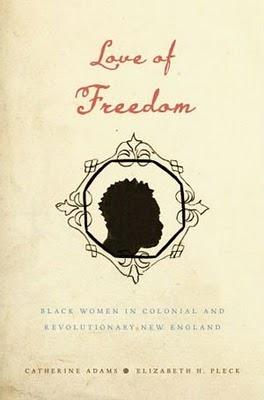Love of Freedom: Black Women in Colonial and Revolutionary New England

That the past is never past is nowhere more apparent than in recent debates over efforts to celebrate “Confederate History Month.” Happily, critics responded to the omission of slavery and the suffering it wrought from the latest official commemorations, still and perhaps forevermore marinated in the intoxicating rhetorical liquor of the “Lost Cause.” And so the sobering scholarship of archival scholars such as Catherine Adams and Elizabeth Pleck, drawing on seventeenth- and eighteenth-century legal records, family papers, genealogical studies, and often on the recorded words of enslaved people themselves is an urgently needed remedy.
Love of Freedom is grounded in two observations: that slavery was certainly not exclusively southern—that New England, too, had a terrible legacy of enslaving African people, although the circumstances of slavery in this region were distinctive in many respects. The second starting point is that while the people kidnapped and enslaved in New England were disproportionately male, African women’s experience of slavery and of the complicated legacies of African and colonial American patriarchy were similarly distinctive and should be studied independently.
Foremost, Love of Freedom is a thick description of the legal and social status of slavery in the northeastern American colonies and, as such, will serve as an important resource for anyone doing research in the field. The authors point out that the first kidnapped African people were taken to Boston only six years after its founding. Only five years later, in 1641, the Massachussetts Bay colony had the dubious distinction of becoming the first British colony to codify slavery legally. By 1700, the authors estimate a black population of one thousand, half living in Massachusetts. Fortunately for historians, the legal status of enslaved people, particularly women, seems to have been a source of continual legal challenge. The result is that we have a surprisingly rich record of direct testimony from enslaved women.
Directly from the voices of women such as Hagar Blackmore we get an account of being kidnapped away from her family in Angola, transported to Barbardos, and sold to a wealthy merchant in Cambridge. From this woman we learn of the vulnerability of enslaved women to rape, and we get some sense of what it meant to be a survivor. The authors point out that the principle of coverture, a convention of English common law in which women’s legal identities were subsumed under those of their husbands, further guaranteed the absence of any sort of reasonable legal protection for enslaved women—or even for free married black women.
As a part of laying to rest the myth of slavery in the north as a benign institution, the book illustrates one manifestation of the idea of coverture. A wife’s killing her husband was, because of established notions of hierarchy, worse than ordinary murder and was, in fact, given a special designation: “petit treason,” for which burning to death was the punishment. Killing a husband—or a master, in the case of enslaved people, was almost—if not quite—on the scale of regicide and was punished accordingly. The book lays out the grim details of human suffering: the archaeological evidence showing widespread malnutrition among black children in the region; the spinal deformations evident among women forced to do laundry, ironing, and household heavy lifting; the forced breeding.
Among the most important archival sources is the record of “freedom suits,” women “seeking possession of their liberty” through manumission or some sort of legal process. Through the testimony extant in these cases, the reader gets a powerful sense of exactly what freedom meant to these women—and what slavery meant. As the authors conclude from these records, “Being stolen from kin and homeland was the central wrong African men and women cited time and again.” And to rectify this crime entailed the re-possession of the self by its rightful owner.